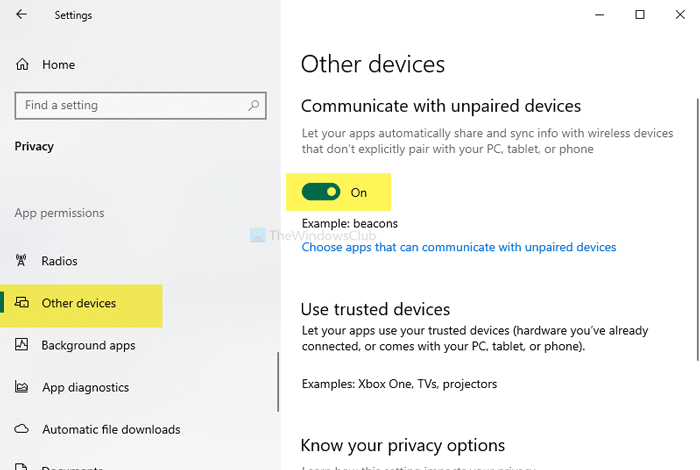Prevent apps from communicating with unpaired devices
To prevent apps from communicating with unpaired devices using Windows Settings, follow these steps- Open the Windows Settings on your computer. For that, press the Win+I buttons together or click the settings gear icon in the Start Menu.
After opening it, go to Privacy > Other devices. Here you will find a heading called Communicate with unpaired devices. By default, it is turned ON. Toggle the button to turn it OFF. There is another option called Choose apps that can communicate with unpaired devices. If you click on this option, you will have to option to choose specific apps according to your requirements.
Block apps from communicating with unpaired devices using Group Policy Editor
To block apps from communicating with unpaired devices using GPO, follow these steps- Open the Local Group Policy Editor. For that, press Win+R, type gpedit.msc, and hit the Enter button. After that, navigate to the following path- On your right-hand side, you will see a setting called Let Windows apps communicate with unpaired devices. Double-click on it and select the Enabled option. Now, you will have to choose Force Deny from the Default for all apps drop-down list.
After that, you can specify the app. Even if you choose the Force Allow option, you will get the same option. For your information, it is required to enter the Package Family Name. At last, click the Apply and OK buttons, respectively.
Prevent apps from communicating with unpaired devices using Registry Editor
To prevent apps from communicating with unpaired devices using Registry Editor, follow these steps- It is recommended to create a System Restore point before making any change in the Registry Editor. Open the Registry Editor. For that, press Win+R, type regedit, and hit the Enter button. After that, navigate to the following path- If you do not find the AppPrivacy, create it manually. For that, right-click on Windows > New > Key, and name it as AppPrivacy. After that, right-click on AppPrivacy > New > DWORD (32-bit) Value and name it as LetAppsSyncWithDevices.
Double-click on it and set the Value data as 2. 2 represents Force Deny. If you want to use the Force Allow option, set the Value data as 1. Like other methods, it is possible to specify an app to prevent it from communicating with unpaired wireless devices. If you want to do so, follow these steps. Otherwise, the above-mentioned Registry change will do the job. After that, right-click on AppPrivacy > New > Multi-String Value and name it as: LetAppsSyncWithDevices_ForceDenyTheseApps Then, double-click on it, and write down the Package Family Name one after one.
Click OK to save the change. However, if you Want to use the Force Allow option, it is required to create a Multi-String Value named LetAppsSyncWithDevices_ForceAllowTheseApps. On the other hand, LetAppsSyncWithDevices_UserInControlOfTheseApps will let other users choose apps manually. To find the Package Family Name of a pre-installed app, follow the same method as mentioned above. That’s all!

